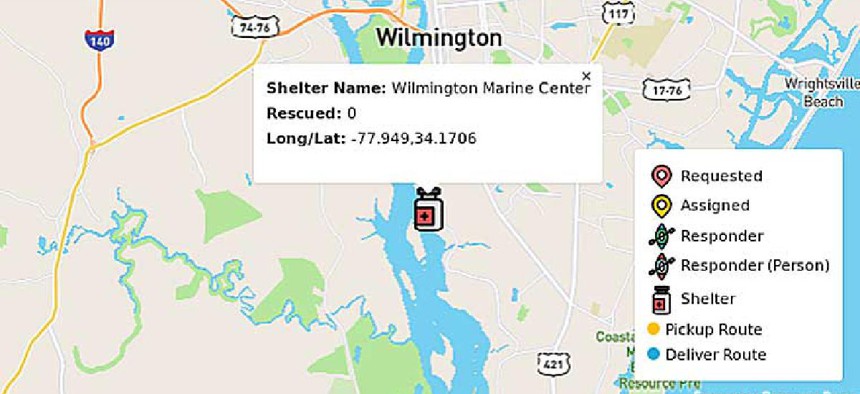Open source community helps responders improve rescue operations


Connecting state and local government leaders
The open source Emergency Response Demo is a “call for aid” application that supports evacuation efforts in hurricane-ravaged areas by helping disaster response officials monitor rescue efforts and match volunteers with boats to people who need evacuation.
History has taught us that no great accomplishments are the result of a single person. Over the past few hundred years, the natural emergent order of things -- the organic evolution of ideas into something meaningful, tangible and often innovative -- has been set in motion by communities of people coming together with big ideas. This mobilization has led to impressive achievements, from the creation of city states and languages to the advent of cloud computing, artificial intelligence and beyond. Harnessing the power of communities, we can make significant strides and advance societal objectives.
We can also save lives. During Hurricane Harvey in 2017, the Federal Emergency Management Agency teamed up with a group of private boat owners called the Cajun Navy to mount rescue efforts. The Cajun Navy, in turn, used social media to recruit others in the boating community to aid in those efforts.
Three different groups of people. One single objective. That’s the power of a community coming together on full display.
The open source community responds
There’s another community that has the potential to be nearly as influential when the next hurricane or tornado strikes. This community doesn’t use boats or helicopters to rescue people; it uses code.
For years, the open source development community has pooled its resources to build solutions that help enterprises navigate the shifting waters of business through agility, flexibility and innovation. Now, that same community is coming together to create applications that can help federal, state and local governments collaborate with ordinary citizens to rescue people caught in emergencies.
It makes sense. After all, the steps involved in successfully responding to a disaster are just as complex as the enterprise business challenges that open source developers regularly address. The difference, of course, is that in the case of an event like a hurricane, tornado or widespread fire, people’s lives are at stake. First responders must be able to identify and contact potential life-saving resources (like the Cajun Navy), locate people in need of rescue and then match the two together -- in real time.
An emergency response “call for aid”
The Emergency Response Demo provides an excellent example of the open source community coming together to address urgent needs. The demo uses several tried-and-true open source technologies and methodologies -- including cloud-native development, agile integration, business process automation, rules-driven logic and event-driven architectures -- to create a way for government officials and citizens to quickly identify and locate individuals who need rescued during a natural disaster.
Inspired by Hurricane Harvey response, the project is a “call for aid” application that supports evacuation efforts in hurricane-ravaged areas. FEMA commanders and local officials can monitor rescue efforts and match volunteers with boats to people who need evacuation.
Incident commanders can use the application as a sort of “virtual base of operations” that gives them a complete view of all incidents, responders and missions as they’re happening. They can easily see the location of people who need saving, the number of boats assigned, how many people are in a particular shelter (which helps in monitoring shelter capacity) and more. Based on this information, officials can relay instructions and dispatch boats to the most critical areas.
Incident commanders can also designate priority zones -- areas in critical need or danger of an impending incident. For example, the damage from a hurricane literally comes in waves: winds down trees, massive flooding follows and additional problems are discovered. Through the application, commanders could receive alerts about an impending event (for instance, a dam in danger of breaking) that could create havoc in a particular area. They can then take proactive action to prioritize evacuations from these impacted regions.
This type of application would not have been possible even a few years ago. Its capabilities are based on microservices -- containerized application development and other agile technologies that have helped make application development far more agile than ever before. We couldn’t have had this type of tool during Hurricane Katrina, for example, as the open source community had not yet developed those technologies. One can only wonder if the outcome would have been different if they had been available.
Collaborating for a rapid response
Just like other notable accomplishments, the Emergency Response Demo isn’t the result of a single developer or architect with a specific background or experience. The build required expertise in different areas, including development, operations, process automation, security and more.
The work put into this application reflects the open source mindset, which calls on different groups of people working collaboratively to achieve a common goal. We’ve seen this with the advent of DevOps and DevSecOps and through ongoing contributions to open source projects, such as Prometheus and Kafka.
Indeed, rapid and iterative development is the essence of open source. The community is driven by the desire for continuous improvement so that the outcomes are always better. That’s the case with the Emergency Response Demo project, too; after every incident, the community revisits what worked, what didn’t and what can be improved before the next natural disaster strikes.
It’s a mindset that has worked well for businesses, and has the power to do just as much good, if not more, for the general public. Together, the open source, government and civilian communities can mount a powerful and unified response that can help save lives.
NEXT STORY: How 911 dispatchers can work from home




